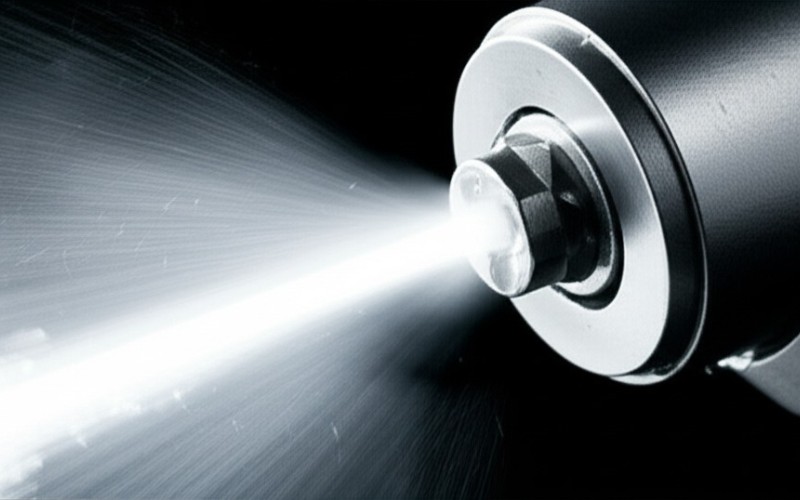
A Dentist’s Guide: Choosing the Right Dental Handpiece Types for Your Practice
Choosing the right one can make your work easier, faster, and more comfortable for your patients. This article will help you understand the differences. This will help you select the best handpieces for your practice and the procedures you perform every day.
Table of Contents
What Is a Dental Handpiece and Why Is It Key?
Let’s start with the basics. A dental handpiece, which some people call a dental drill, is a tool that holds and spins a dental bur or prophy cup. Dental handpieces are essential tools in every dental clinic. They help a dentist with many different dental procedures. This can be anything from cleaning teeth to complex surgeries.
The right handpiece makes a huge difference. A good handpiece feels balanced in your hand. It gives you great control and power. A bad one can cause hand fatigue and lead to poor results. Think about the types of procedures you do most often. This will help you understand which handpiece is the best fit. Having the right tool for the job is the first step to great dental care.
These tools are at the heart of modern dentistry. We use them for cavity preparations, polishing, and so much more. There are various types of dental handpieces available. Understanding these common types is vital for any dental professional. The handpiece you choose affects your work and your patient’s experience.
Should I Choose Air-Driven or Electric Handpieces?
The two main handpiece types are air-driven and electric. Both have a motor that spins the dental bur. But how the handpieces work is very different. Air-driven handpieces use compressed air to power a small turbine. This turbine spins the bur. They are simple, reliable, and often less expensive. Air-driven handpieces are lighter, which can be a big plus during long procedures.
On the other hand, electric handpieces use an electric motor. This gives them constant torque and speed. An electric handpiece does not slow down when it meets resistance. This is great for cutting through tough materials. Electric handpieces offer more control and precision. Many electric handpiece systems come with a variable speed setting. You can set the exact rpm you need for a specific job.
The choice between air-driven and electric handpieces comes down to your needs and budget. The air-driven handpiece is a classic for a reason. But the power and control of electric dental handpieces are hard to ignore. Many practices use a mix of both types of handpieces.
When Do I Need High-Speed Handpieces?
High-speed handpieces are the most common handpiece in any dental office. These tools operate at a very high rpm, often over 200,000 rpm. This incredible speed is needed for cutting hard tissues like tooth enamel. They are essential for procedures like cavity preparations or removing old crowns.
Most high-speed dental handpieces are air-driven. The high-speed air-driven handpieces are powerful and efficient. They usually have a built-in water spray to keep the tooth cool. This prevents damage to the pulp. When choosing a high-speed handpiece, better look at its power, noise level, and how it feels in your hand. The handpiece weight is also important to avoid getting tired.
High-speed dental tools are designed for precision and speed. The different types of handpieces still include these as a core tool. You cannot run a modern dental practice without a good set of high-speed dental handpieces. They are powerful and a must-have for so many common dental procedures.

What Are Low-Speed Handpieces Used For in Dentistry?
While high-speed gets a lot of attention, low-speed handpieces are just as important. Think of them as the versatile players on the team. Low-speed handpieces operate at a much slower speed, usually under 40,000 rpm. This slower speed gives you more control and torque. This makes them perfect for different tasks.
Low-speed handpieces are used for things like polishing teeth and finishing restorations. They are also used for removing soft decay and for some endodontic and implant procedures. The low-speed handpiece has different attachments. You can attach a prophy angle for polishing or a contra-angle for removing decay. This makes them very useful.
Low-speed dental handpieces come in both air-driven and electric models. Electric low-speed models offer amazing torque control. Low-speed handpieces are typically very durable. You will find that these handpieces are used in dental labs as well as in the clinic. Every dentist needs a reliable slow-speed handpiece.
What Are Specialized Surgical Handpieces?
For some procedures, you need more than a standard handpiece. Surgical handpieces are designed for oral surgery. They are good for things like removing impacted wisdom teeth. These handpieces must be very strong and reliable. They are often made from high-quality stainless steel and can be fully sterilized.
Surgical handpieces usually have a simple design to make them easy to clean. They also have external irrigation lines. This is to deliver sterile saline or water to the surgical site. This is different from the internal water spray on a high-speed handpiece. The goal is to keep the area clean and cool without spraying air into the patient’s tissue.
These handpieces are a special type of dental handpiece. They give surgeons the torque and control they need for difficult bone-cutting procedures. If your practice performs oral surgery, having dedicated surgical handpieces is not just an option; it is a requirement for patient safety.
How Are Implant Handpieces Different?
Placing a dental implant requires extreme precision. That is why implant handpieces were created. These are a special type of low-speed handpiece. They are designed to give the dentist total control over speed and torque. This is very important when preparing the bone for an implant. You need the right torque to ensure the implant is stable.
An implant handpiece is almost always part of an electric handpiece system. This system allows you to set a very specific rpm and torque level. The implant handpieces are designed to be used with external irrigation. This is just like surgical handpieces. It helps to keep the bone from getting too hot during the procedure.
Never attempt an implant case without a proper implant handpiece. The control they provide is unmatched. If you are getting into implant dentistry, investing in a high-quality implant handpiece is one of the most important steps you will take. It ensures safety and predictable results for your patients.
Why Are Endodontic Handpieces a Must for a Root Canal?
A root canal procedure is all about cleaning and shaping the inside of a tooth. This is a delicate job. Endodontic handpieces are made just for this. They are designed to drive endodontic files. These files clean and shape the root canal system. These handpieces are very different from the ones we use for cutting cavities.
Many endodontic handpieces are electric. They offer precise speed and torque control. This is key to preventing the endodontic file from breaking inside the root canal. Many modern endodontic handpieces have special features. They may have auto-reverse functions that pull the file back if it gets stuck. This is a huge safety feature.
Using a dedicated handpiece for endodontic procedures can make a root canal faster and safer. In early days, dentists did this all by hand. The new endodontic handpieces have changed the game. They help dentists perform endodontic treatment with more confidence and better outcomes. They are a vital tool for this type of dental work.
How Do I Select the Best Dental Handpiece?
Choosing the best dental handpiece for your practice can feel overwhelming. Focus on a few key things. First, think about the types of procedures you perform most often. This will tell you if you need to focus on high-speed, low-speed, or specialized handpieces. For a general practice, a mix of high-speed and low-speed handpieces is a good start.
Next, consider air-driven versus electric. Air-driven handpieces are lighter and cheaper. Electric handpieces offer more power and control. I suggest trying both if you can. See what feels best in your hand. Handpiece weight and balance are very important for your comfort.
Finally, think about your long-term partner to supply your practice with handpieces. Look at the warranty, repair options, and customer support. A good handpiece is an investment. You want a company that will stand behind their dental handpieces. Choosing the right dental handpiece is a big decision, so take your time and do your research.

Should I Invest in Complete Handpiece Systems?
When you buy a new handpiece, you are often buying into a system. This is especially true for electric handpieces. An electric dental handpiece system usually includes a control unit, an electric motor, and the handpiece itself. These systems allow you to control the speed and torque with great precision.
I have found that investing in good dental handpiece systems pays off. They allow one motor to power different handpieces. You can use the same electric motor for a low-speed handpiece for polishing and then for an endodontic handpiece for a root canal. This can be cost-effective in the long run.
These handpiece systems also make it easier to add new technology. When you want to start doing implant or endodontic procedures, you may only need a new attachment, not a whole new setup. It is wise to select the best system that can grow with your practice. Supply your practice with handpieces that give you options for the future.
A Quick Word on Handpiece Maintenance
Your handpieces are some of the most used pieces of dental equipment in your office. They must be cleaned and sterilized after every patient. Proper maintenance is key to making them last. A little bit of care goes a long way.
Follow the manufacturer’s guide to dental handpiece maintenance. This usually involves cleaning the outside, purging the lines, and lubricating the inside. Regular care prevents costly handpiece repair bills. It also ensures your handpieces work well when you need them.
Taking care of your dental handpieces is just as important as choosing the right ones. A well-maintained handpiece is a reliable handpiece. It is a simple step that protects your investment and ensures your tools are always ready for your next patient. Handpieces that give you unmatched performance are ones that are well-cared for.
Frequently Asked Questions (FAQ)
Q1: What are the most common types of dental handpieces used in a general practice?
A general dental practice mostly uses two common types of handpieces: high-speed air-driven handpieces for cutting teeth and low-speed handpieces for polishing, finishing, and decay removal.
Q2: Are electric handpieces better than air-driven handpieces?
It depends on what you value. Electric handpieces offer constant power and more control, which is great for precision work. However, air-driven handpieces are lighter, simpler, and less expensive. Many dentists find that having both types is the best solution.
Q3: How often do I need to replace my dental handpieces?
There is no set timeline. With proper care and regular maintenance, a quality dental handpiece can last for many years. You will need to consider handpiece repair or replacement when it starts to lose power, make strange noises, or no longer holds the bur securely.




